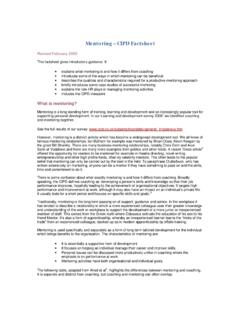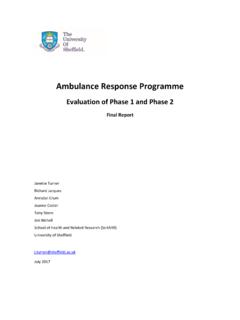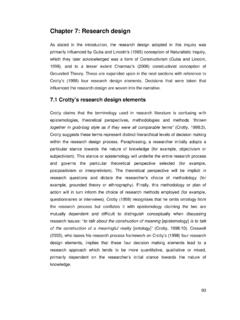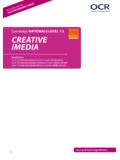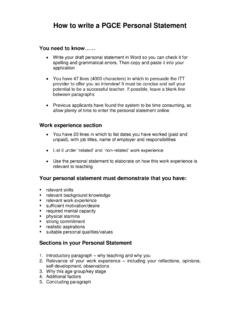Transcription of The key to employability: The key to developing a ...
1 The current issue and full text archive of this journal is available at The key to The key to employability : employability developing a practical model of graduate employability 277. Lorraine Dacre Pool and Peter Sewell Centre for employability , University of Central Lancashire, Preston, UK. Abstract Purpose The purpose of this paper is to introduce a straightforward, practical model of employability that will allow the concept to be explained easily and that can be used as a framework for working with students to develop their employability . Design/methodology/approach The model was developed from existing research into employability issues and the experience of the authors. The various elements of employability included in the model are discussed and their inclusion justified on the basis of existing research.
2 Findings The model sets out exactly what is meant by employability , in clear and simple terms, and the model suggests directions for interaction between the various elements. Research limitations/implications The relationships between and the interaction of the elements within the model remain theoretical. Further research to test the model is planned and will be reported on at a later date. Practical implications The model can be used to explain the concept of employability to those new to the subject, and particularly to students and their parents. It will be a useful tool for lecturers, personal tutors, careers advisors and any other practitioners involved in employability activities. It will also be used to develop a measurement tool for employability . Originality/value This paper seeks to fill the gap between in-depth, scholarly and complex articles or books about employability and very simple descriptive articles.
3 It will be of value to anybody with an interest in employability issues. Keywords , Employment, Career development , Higher education, Graduates, Modelling, United Kingdom Paper type Research paper Introduction In recent years a number of models of employability have been proposed. Whilst these models go some way towards capturing the meaning of this elusive concept of employability , they are either too elaborate to be practically useable or too simple to do justice to this multifaceted issue. For many people employability is simply about getting a job, and the term is increasingly used carelessly and interchangeably with enterprise , which in turn is confused with entrepreneurship . The aim of this paper is to present a practical, coherent model,that is firmly based on existing research findings in employability and on the various individual elements that make up the framework.
4 employability is an issue of concern in many areas of the economy, but in this context the focus is on students and graduates in UK higher education. Education Training Vol. 49 No. 4, 2007. pp. 277-289. q Emerald Group Publishing Limited The authors wish to thank Lionel Bunting for his helpful suggestions with the visual 0040-0912. presentation of the model. DOI ET employability in higher education 49,4 Current interpretations of employability range from the use of simple measures, such as whether or not a graduate has secured a job (using graduate first destination surveys), to in-depth scholarly books on the subject. If employability is measured in the simplistic terms of whether or not a graduate has managed to secure a job within six months of graduating, it only provides a very vague and imprecise indication of what 278 the student has gained.
5 Questions need to be asked about whether or not the graduate is using the skills , knowledge and understanding gained in their degree studies in a graduate level job , which in turn opens up a whole new debate about what exactly a graduate level job entails. There is so much more to employability than gaining employment, and first destination statistics do not take into account the fact that some graduates may have taken lower level jobs in order to deal with financial pressures, particularly after incurring debts through their studies. Hillage and Pollard (1998, p. 2) suggest that: In simple terms, employability is about being capable of getting and keeping fulfilling work. More comprehensively employability is the capability to move self-sufficiently within the labour market to realise potential through sustainable employment.
6 They propose that employability consists of four main elements. The first of these, a person's employability assets , consists of their knowledge, skills and attitudes. The second, deployment , includes career management skills , including job search skills . Thirdly, presentation is concerned with job getting skills , for example CV writing, work experience and interview techniques. Finally, Hillage and Pollard (1998) also make the important point that for a person to be able to make the most of their employability assets , a lot depends on their personal circumstances (for example family responsibilities) and external factors (for example the current level of opportunity within the labour market). Bennett et al. (1999) proposed a model of course provision in higher education which included five elements: (1) disciplinary content knowledge.
7 (2) disciplinary skills ;. (3) workplace awareness;. (4) workplace experience; and (5) generic skills . This model goes some way towards including all the necessary elements to ensure a graduate achieves an optimum level of employability , but is still missing some vital elements. The USEM account of employability (Yorke and Knight, 2004; Yorke and Knight, 2004) is probably the most well known and respected model in this field. USEM is an acronym for four inter-related components of employability : (1) understanding;. (2) skills ;. (3) efficacy beliefs; and (4) metacognition The authors suggest that behind the USEM model is: The key to .. an attempt to put thinking about employability on a more scientific basis, partly because employability of the need to appeal to academic staff on their own terms by referring to research evidence and theory (Knight and Yorke, 2004, p 37).
8 The USEM model forms part of a large body of research-based scholarly work on employability . However, this strength could also be perceived as a weakness, in 279. that it does not assist in explaining to non-experts in the field, particularly the students themselves and their parents, exactly what is meant by employability . The Centre for employability (CfE) at the University of Central Lancashire (UCLan). in the UK has been developing practical solutions to enhance the prospects of students and graduates for over ten years. As a consequence of the careers service origins of this unit, the main theoretical model that has underpinned this work has been the DOTS. model (Law and Watts, 1977), which consists of: .. planned experiences designed to facilitate the development of: Decision learning decision making skills Opportunity awareness knowing what work opportunities exist and what their requirements are Transition learning including job searching and self presenting skills Self awareness in terms of interests, abilities, values, etc.
9 (Watts, 2006, pp. 9-10). The value of this model lies in its simplicity, as it allows individuals to organise a great deal of the complexity of career development learning into a manageable framework. However, the model has recently attracted some criticism. McCash (2006) argues that the model is over-reliant on a mechanistic matching of person and environment, and therefore underplays other critical issues such as social and political contexts. He also points out that there is an implication that failure to secure a self-fulfilling occupation can be presented, or experienced, as the fault of the unsuccessful individual. These criticisms overlook the fact that the elegant simplicity of the DOTS model is precisely why it has proved so enduring and popular. They also seem to suggest that students introduced to basic concepts of career development through DOTS would be incapable of developing and learning about more sophisticated analyses through this simple introductory structure.
10 The concerns raised in the CfE about DOTS in relation to employability are different. For some time, it has become evident that the model has shortcomings when it is applied beyond careers education to the broader concept of employability . An early effort to capture the CfE definition of employability was reported in Hinchcliffe (2001, p. 8): Reflecting the range of views we see Peter Sewell of the CLASS Faculty Centre for employability making the career development case and defining employability as: Having a set of skills , knowledge and personal attributes that make a person more likely to secure, and be successful in their chosen occupation. The most recent articulation of this, which incorporates an important additional new element of satisfaction , stems from the recognition that from an individual's perspective a person may be successful in their chosen occupation but not necessarily satisfied: ET employability is having a set of skills , knowledge, understanding and personal attributes that make a person more likely to choose and secure occupations in which they can be 49,4 satisfied and successful.

